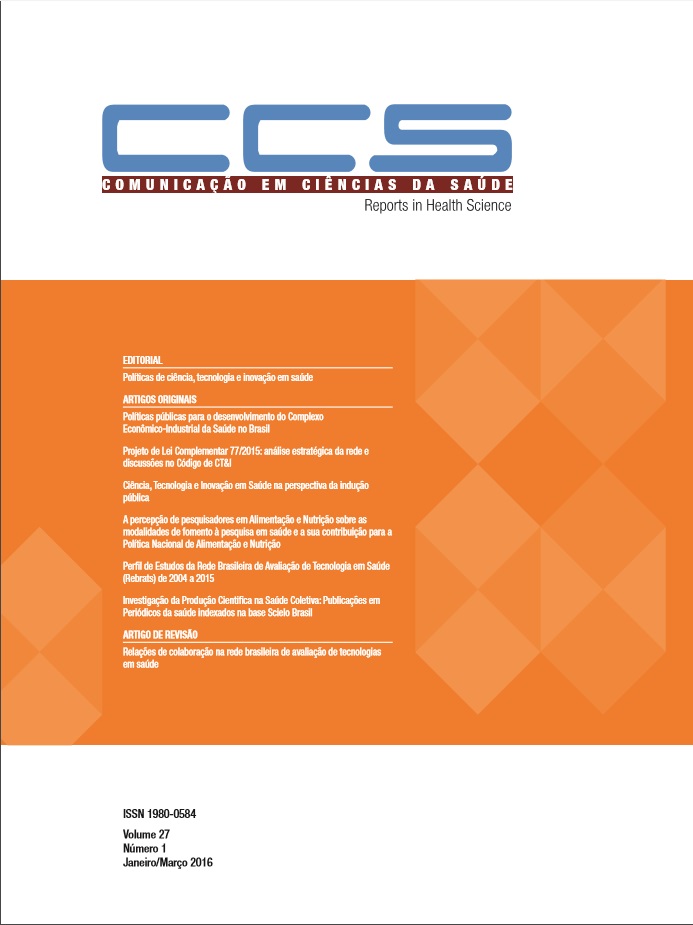Project of Complementary Law 77/2015: strategic network analysis and discussions in CT&I code
DOI:
https://doi.org/10.51723/ccs.v27i01.83Keywords:
Intelligence, Network analysis, Actors mappingAbstract
Objective: To demonstrate how the data available in cyberspace became intelligence tool to guide the mapping of actors and analysis of networks that aim to strategic thinking for decision making in relation to the Project of Complementary Law 77 / 2105.
Method: An exploratory study of a descriptive nature with use of the methodology of Social Network Analysis. Data were obtained through access to Google, in the view of the first three pages of search and cutouts according to the Critical Uncertainties (ICs) considered driving. Then, there was the lifting of the actors and their association with each of the five ICs. The data were refined spreadsheet and entered the following software for the processing and correlation of data: ORA, Gephi, Excel and Wordle.
Results: The results show the network of actors, according to the linkage of areas of interest, and the analysis of the words mentioned in the speeches. Five areas of interest were detected: Environments innovation promoters; Integrating chains to generate knowledge with the technological production at all stages of the R & D process; technology transfer for the development of national industry; training mechanisms and fixation of researchers in the most underserved regions of the country; Implementation of technology parks. The greatest interest of Actors is on Technology Transfer and Technology Parks Deployment.
Conclusion: The open information are inputs that can be collected and systematized and, with the ARS support, become an intelligence tool to guide strategic thinking and decision making.
Downloads
References
2. Mandell M. “Network management: strategic behavior in the public sector”. In: GAGE, Robert: Mandell, Myrna. Strategies for managing intergovernmental policies and network. New York: Praeger, 1990.
3. Latour B. Jamais fomos modernos: ensaio de antropologia simétrica. Tradução de Carlos Irineu da Costa. Rio de Janeiro: Editora 34, 1994.
4. Castells M. A sociedade em rede. São Paulo: Paz e Terra, 1999.
5. Marteleto R. Redes sociais, mediação e apropriação de informação: situando campo, objetos e conceitos na pesquisa em ciência da informação. Tendências da Pesquisa Brasileira em Ciência da Informação. Brasília, 2010; 3(1): 27‑46.
6. Wasserman S; Faust K. 1994. Social network analysis: methods and applications. Cambridge: Cambridge University Press, 1994. 857 p.4.
7. Freeman R E. Strategic Management: A Stakeholder Approach. Boston: Pitman, 1984.
8. Levy P. A inteligência coletiva. São Paulo: Edições Loyola, 1998.
9. Nooy W de; Mrvar A; Batagelj V. Exploratory social network 216 analysis with Pajek. New York: Cambridge University Press, 2011.
10. Newman M E J. Networks: an introduction. Oxford , NY: Oxford University Press, 2010.
11. Martins W J. Gestão estratégica das redes cooperativas de ciência, tecnologia e inovação em saúde: um modelo para o desenvolvimento socioeconômico e a sustentabilidade do SUS. / Wagner de Jesus Martins. ‑‑ 2013: Tese (Doutorado) – Escola Nacional de Saúde Pública Sergio Arouca, Rio de Janeiro, 2013.
12. Fleury S. Redes de políticas: novos desafios para gestão pública. Administração em Diálogo. 2005; 7(1): 77‑89.
13. Mueller S P M. Métodos para pesquisa em Ciência da Informação. Brasília: Thesaurus, 2007.
Downloads
Published
Issue
Section
License
Declaro para os devidos fins que o artigo que estou submetendo representa um trabalho original e nunca foi publicado total ou parcialmente, e que se alguma de suas partes foi publicada possuímos autorização expressa para a publicação no periódico Comunicação em Ciências da Saúde (CCS). Esse artigo não foi enviado a outro periódico e não o será enquanto estiver sendo considerada sua publicação; caso venha a ser aceito não será publicado em outro periódico; e não contém material difamatório ou ilegal sob nenhuma forma, não viola a intimidade de terceiros, nem infringe direitos protegidos.
Eu e demais autores desse trabalho certificamos por meio desta declaração que:
- Concordamos com as normas editoriais e com o processo de revisão da CCS;
- Aceitamos a responsabilidade pela conduta desse estudo e pela análise e interpretação dos dados;
- Cooperaremos, sempre que solicitado, na obtenção e fornecimento de dados sobre os quais o manuscrito está baseado, para exame dos avaliadores;
- Não estão sendo omitidos quaisquer ligações ou acordos de financiamento entre os autores e companhias ou pessoas que possam ter interesse no material abordado no artigo;
- Não estão sendo excluídos ou omitidos deste artigo autores ou instituições participantes;
- Possuímos permissão para uso de figuras e tabelas publicadas em outras fontes;
- Possuímos permissão das pessoas e instituições citadas nos agradecimentos;
- O autor correspondente autoriza a publicação do endereço informado e e-mail do(s) autor(es) junto com o artigo;
- Assumimos a responsabilidade pela entrega de documentos verídicos;
- Autorizamos a publicação do referido artigo no periódico Comunicação em Ciências da Saúde, segundo critérios próprios e em número e volume a serem definidos pelo editor do periódico;
- Nos comprometemos a atender os prazos estipulados pelos editores do periódico Comunicação em Ciências da saúde;
- Estamos cientes de que a não manifestação no prazo de dois dias da revisão da diagramação, recebida por e-mail, será considerado aprovado para publicação.








